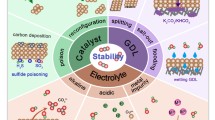Abstract
We used density functional theory to investigate the electrochemical CO2 reduction and competing hydrogen evolution reaction on model Au, Ag, Cu, Ir, Ni, Pd, Pt, and Rh nanoparticles. On the coinage metal, the free energy of adsorbed COOH, CO, and H intermediates generally becomes more favorable with decreasing particle size. This pattern was also observed on all transition metals with the binding of the intermediates observed to be stronger on almost all of these metals. Comparative studies of the reaction profile reveal that H2 evolution is the first reaction to be energetically allowed at zero applied bias.




Similar content being viewed by others
References
D.T. Whipple and P.J. Kenis: Prospects of CO2 utilization via direct heterogeneous electrochemical reduction. J. Phys. Chem. Lett. 1, 3451 (2010).
Y. Hori: Electrochemical CO2 reduction on metal electrodes. In Modern Aspects of Electrochemistry, edited by C.G. Vayenas, R.E. White, and M.E. Gamboa-Aldeco (Springer, New York, 2008, p. 1).
M. Gattrell, N. Gupta, and A. Co: A review of the aqeous electrochemical reduction of CO2 to hydrocarbons at copper. J. Electrochem. Chem. 594, 1 (2006).
M. Aresta: Carbon Dioxide as Chemical Feedstock (Wiley, Wienheim, 2010).
I. Ganesh: Conversion of carbon dioxide into methanol—a potential liquid fuel: fundamental challenges and opportunity. Renew. Sustain. Energy Rev. 31, 221 (2014).
E.E. Benson, C.P. Kubiak, A.J. Sathrum, and J.M. Smieja: Electrocatalytic and homogeneous approaches to conversion of CO2 to liquid fuels. Chem. Soc. Rev. 38, 89 (2009).
W. Zhu, R. Michalski, O. Metin, H. Lv, S. Guo, C.J. Wright, X. Sun, A.A. Peterson, and S. Sun: Monodisperse Au nanoparticles for selective electrocatalytic reduction of CO2 to CO. J. Am. Chem. Soc. 135, 16833 (2013).
H. Mistry, R. Reske, Z. Zeng, Z-J. Zhao, J. Greeley, P. Strasser, and B. Roldan Cuenya: Exceptional size-dependent activity enhancement in the electroreduction of CO2 over Au nanoparticles. J. Am. Chem. Soc. 136, 16473 (2014).
R. Reske, H. Mistry, F. Behafarid, B. Cuenya, and P. Strasser: Particle size effects in the catalytic electroreduction of CO2 on Cu nanoparticles. J. Am. Chem. Soc. 136, 6978 (2014).
D. Gao, H. Zhou, J. Wang, S. Miao, F. Yang, G. Wang, J. Wang, and X. Bao: Size-dependent electrocatalytic reduction of CO2 over Pd nanoparticles. J. Am. Chem. Soc. 137, 4288 (2012).
G. Kresse and J. Hafner: Ab initio molecular dynamics for liquid metals. Phys. Rev. B 47, 558 (1993).
G. Kresse and J. Furthmüller: Effeciency of Ab-initio total energy calculations for metals and semiconductors using a plane-wave basis set. Comput. Mater. Sci. 6, 15 (1996).
J.P. Perdew, K. Burke, and M. Enzerhof: Generalized gradient approximation made simple. Phys. Rev. Lett. 77, 3865 (1996).
G. Kresse and D. Joubert: From ultrasoft pseudopotentials to the projector augmented wave method. Phys. Rev. B 59, 1758 (1999).
W. Tang, L. Zhang, and G. Henkelman: Catalytic activity of Pd/Cu random alloy nanoparticles for oxygen reduction. J. Phys. Chem. Lett. 2, 1328 (2011).
C.J. Cramer: Essentials of Computational Chemistry: Theories and Models, 2nd ed. (Wiley: West Sussex, 2004).
A.A. Peterson, F. Abild-Pedersen, F. Studt, J. Rossmeisl, and J.K. Norskov: How copper catalyzes the electroreduction of carbon dioxide into hydrocarbon fuels. Energy Environ. Sci. 3, 1311 (2010).
H.A. Hansen, J.B. Varley, A.A. Peterson, and J. Norskov: Understanding trends in the electrocatalytic activity of metals and enzymes for CO2 reduction to CO. J. Phys. Chem. Lett. 4, 388 (2013).
W. Zhu, W.J. Zhang, H. Zhang, H. Lv, Q. Li, R. Michalski, A.A. Peterson, and S. Sun: Active and selective conversion of CO2 to CO on ultrathin Au nanowires. J. Am. Chem. Soc. 136, 16132 (2014).
B. Hammer, L.B. Hansen, and J. Norskov: Improved adsorption energetics within density functional theory using revised Perdew–Burke–Enzerhoff functionals. Phys. Rev. B 59, 7413 (1999).
S. Back, M.S. Yeom, and Y. Jung: Active sites of au and Ag nanoparticle catalysts for CO2 electroreduction to CO. ACS Catal. 5, 5089 (2015).
D. Gao, H. Zhou, J. Wang, S. Miao, F. Yang, G. Wang, J. Wang, and X. Bao: Size-dependent electrocatalytic reduction of CO2 over Pd nanoparticles. J. Am. Chem. Soc. 137, 4288 (2015).
V. Tripkovic, M. Vanin, M. Karamad, M.E. Bjorketum, K.W. Jacobsen, K.S. Thygesen, and J. Rossmeisl: Electrochemical CO2 and CO reduction on metal-functionalized porphyrin-like graphene. J. Phys. Chem. C 117, 9187 (2013).
Acknowledgments
This report was prepared as an account of work sponsored by an agency of the US Government. Neither the US Government nor any agency thereof, nor any of their employees, makes any warranty, express or implied, or assumes any legal liability or responsibility for the accuracy, completeness, or usefulness of any information, apparatus, product, or process disclosed, or represents that its use would not infringe privately owned rights. Reference herein to any specific commercial product, process, or service by trade name, trademark, manufacturer, or otherwise does not necessarily constitute or imply its endorsement, recommendation, or favoring by the United States Government or any agency thereof. The views and opinions of author(s) expressed herein do not necessarily state or reflect those of the US Government or any agency thereof.
Author information
Authors and Affiliations
Corresponding author
Supplementary Materials
Supplementary Materials
The supplementary material for this article can be found at https://doi.org/10.1557/mrc.2017.67.
Rights and permissions
About this article
Cite this article
Alfonso, D.R., Kauffman, D.R. Assessment of trends in the electrochemical CO2 reduction and H2 evolution reactions on metal nanoparticles. MRS Communications 7, 601–606 (2017). https://doi.org/10.1557/mrc.2017.67
Received:
Accepted:
Published:
Issue Date:
DOI: https://doi.org/10.1557/mrc.2017.67




